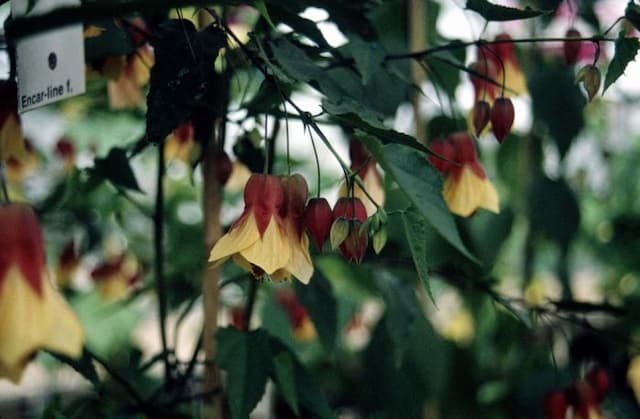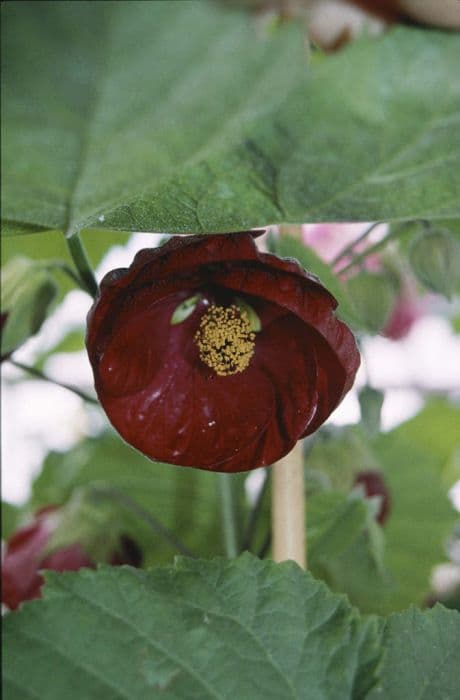Rose of Sharon Hibiscus syriacus Blue Chiffon = 'Notwood3' (PBR) (Chiffon Series) (d)
![rose of Sharon [Blue Chiffon]](/_next/image?url=https%3A%2F%2Fplants-admin.emdemapps.com%2Fimages%2Fplants%2F%2Fimages%2F604b645523cc4.png&w=3840&q=75)
ABOUT
The Hibiscus syriacus Blue Chiffon, also known simply as Blue Chiffon Rose of Sharon, is a deciduous shrub that is admired for its ornamental qualities. This cultivar is particularly celebrated for its lush flowers. The blossoms are a beautiful pale blue, often exhibiting a rich, lavender-blue hue that appears soft and delicate to the eye. Each flower is multi-layered, with the appearance of a chiffon fabric, giving a semi-double to double bloom effect that adds depth and texture. The petals of the Blue Chiffon Rose of Sharon have a ruffled appearance, contributing to the overall elegance of the bloom. At the center of the flowers, there is a prominent and contrasting reddish-purple heart, which is composed of a stamen column that attracts pollinators. The blooms are surrounded by green foliage that serves as a lovely backdrop, ensuring that the flowers stand out spectacularly. The leaves are typically medium green, ovate to triangular in shape, with a slightly glossy texture and some serration along the margins. Flowering abundantly, the Blue Chiffon Rose of Sharon provides a long-lasting display that brightens up gardens and landscapes. Its blossoms can appear from midsummer until early fall, offering a lengthy season of interest. This plant is often utilized in garden designs as a focal point because of its showy flowers, which can also attract butterflies and bees. When not in bloom, the plant's upright, bushy form and green foliage maintain visual interest throughout the growing season.
About this plant
 Names
NamesFamily
Malvaceae
Synonyms
Blue Chiffon Rose of Sharon, Blue Chiffon Althea
Common names
Hibiscus syriacus 'Notwoodthree', Hibiscus syriacus 'Notwood3'.
 Toxicity
ToxicityTo humans
The plant commonly known as Rose of Sharon is not toxic to humans. Ingesting parts of this plant is not known to cause any harmful effects or symptoms of poisoning.
To pets
The Rose of Sharon plant is not highly toxic to pets. However, if ingested in large quantities by pets, it could potentially lead to some gastrointestinal upset, including vomiting and diarrhea. It's always best to consult a veterinarian if you suspect your pet may have ingested any part of the plant and is showing symptoms.
 Characteristics
CharacteristicsLife cycle
Perennials
Foliage type
Deciduous
Color of leaves
Green
Flower color
Blue
Height
8-12 feet (2.4-3.7 meters)
Spread
6-10 feet (1.8-3 meters)
Plant type
Shrub
Hardiness zones
5-8
Native area
Asia
Benefits
 General Benefits
General Benefits- Ornamental Appeal: The Hibiscus syriacus Blue Chiffon offers large, attractive double flowers with a delicate blue tint that enhance the aesthetic of gardens and landscapes.
- Long Flowering Period: It has a long blooming season, often from mid-summer to autumn, providing consistent color for an extended period.
- Drought Tolerance: Once established, this variety of hibiscus is quite tolerant of short periods of drought, making it suitable for various climates and weather conditions.
- Easy Maintenance: The plant is relatively low-maintenance, requiring minimal care once planted, which can be ideal for both novice and expert gardeners.
- Cold Hardy: It is capable of withstanding colder temperatures, making it suitable for growth in a range of climatic zones.
- Wildlife Attraction: The flowers can attract pollinators such as bees and butterflies, promoting biodiversity in the garden.
- Screening Plant: It can be used as a hedge or privacy screen due to its bushy growth habit, providing a natural boundary or backdrop for garden spaces.
- Mixture with Other Plants: The Blue Chiffon's cool-toned flowers mix well with other plants in beds and borders, offering garden designers a beautiful option for color schemes.
- Versatile Landscaping: The plant is versatile in terms of landscaping, suitable for specimen plantings, mixed borders, and foundation plantings.
 Medical Properties
Medical PropertiesThis plant is not used for medical purposes.
 Air-purifying Qualities
Air-purifying QualitiesThis plant is not specifically known for air purifying qualities.
 Other Uses
Other Uses- Hair care: The flowers of the Rose of Sharon can be used to make natural hair rinses, which are believed to add shine and volume to hair.
- Artistic dye: The petals can be used to create a natural dye for fabrics, paper, or even in art projects, producing delicate shades of color.
- Edible garnish: The flowers, which are edible, can be used as colorful garnishes for salads and desserts, adding a touch of elegance.
- Plant ink: The juice from the petals can be used to create a botanical ink for writing or drawing, offering a unique hue and texture.
- Leaf shine: Leaves of the Rose of Sharon can be used to polish wood furniture, leaving behind a glossy finish without the use of chemicals.
- Floral arrangements: The long-lasting flowers are perfect for cut flower arrangements, bringing a pop of color indoors.
- Companion planting: Rose of Sharon can be planted in gardens to attract pollinators, which helps improve the yield of vegetable and fruit gardens nearby.
- Cooking flavoring: Some cultures use the flowers to impart a subtle flavor to certain dishes, although this is less common and should be done with caution to avoid consuming any harmful parts of the plant.
- Beverage infusion: The flowers can be used to infuse water or spirits, giving them a floral note that can be appreciated in gourmet culinary preparations or cocktails.
- Potpourri: Dried Rose of Sharon flowers can be included in potpourri mixes for a light, pleasant fragrance in the home.
Interesting Facts
 Feng Shui
Feng ShuiThe Rose of Sharon is not used in Feng Shui practice.
 Zodiac Sign Compitability
Zodiac Sign CompitabilityThe Rose of Sharon is not used in astrology practice.
 Plant Symbolism
Plant Symbolism- Delicate Beauty: The intricate, delicate blooms of the Hibiscus syriacus, commonly known as Rose of Sharon, symbolize beauty, femininity, and gentleness, reflecting its soft, chiffon-like petals.
- Ephemeral Nature: As the flowers of the Rose of Sharon typically last for only a short period, they often symbolize the fleeting nature of beauty and life's temporary states.
- Renewal and Rebirth: Since the Rose of Sharon is a hardy plant that blooms annually, it can symbolize renewal, rebirth, and the ability to rejuvenate after difficult conditions.
- Love and Attraction: The Rose of Sharon's showy flowers are also associated with love and attraction, sometimes used to signify a perfect lover or an unrequited love.
- National Symbolism: In South Korea, the Rose of Sharon (mugunghwa) serves as the national flower and is connected with perseverance and eternal beauty, as well as national pride and cultural identity.
 Water
WaterThe Rose of Sharon requires regular watering, especially during dry spells. It should be watered deeply once a week, providing it with about 1 to 1.5 gallons of water each time. During the hotter months, the frequency may increase to twice a week. Always check the soil moisture before watering; the top inch of the soil should be dry to the touch. Avoid overwatering, as this can lead to root rot.
 Light
LightThe Rose of Sharon thrives in full sun but can tolerate partial shade. The ideal spot would receive at least six hours of direct sunlight daily to ensure abundant flowering. However, in extremely hot climates, some afternoon shade can help to protect the plant from heat stress.
 Temperature
TemperatureThe Rose of Sharon is adaptable to a variety of temperatures and can survive in USDA hardiness zones 5 through 8. It can withstand minimum temperatures down to about -10 to -20 degrees Fahrenheit and can handle high temperatures as well. The ideal growing temperature for the Rose of Sharon ranges from 60 to 85 degrees Fahrenheit.
 Pruning
PruningPruning the Rose of Sharon is important for maintaining its shape and encouraging flower production. It's best to prune in late winter or early spring before new growth starts. Pruning can be done annually; remove dead or crossing branches and to open up the plant's structure. Occasional thinning may be required to enhance airflow and light penetration.
 Cleaning
CleaningAs needed
 Soil
SoilRose of Sharon (common name for Hibiscus syriacus Blue Chiffon) thrives in well-draining soil enriched with organic matter. A good soil mix consists of two parts loam, one part peat moss or compost, and one part sand or perlite to ensure proper drainage. The ideal soil pH for Rose of Sharon is slightly acidic to neutral, ranging from 6.0 to 7.5.
 Repotting
RepottingRose of Sharon is typically grown as a shrub in the ground and does not require frequent repotting. If grown in a container, young plants may need repotting every two to three years to accommodate root growth.
 Humidity & Misting
Humidity & MistingRose of Sharon prefers average to high humidity levels but is adaptable to a wide range of humidity conditions. It does well in the humidity levels typically found in outdoor garden environments.
 Suitable locations
Suitable locationsIndoor
Provide bright light and room to grow.
Outdoor
Plant in full sun, shelter from strong winds.
Hardiness zone
5-9 USDA
 Life cycle
Life cycleHibiscus syriacus 'Blue Chiffon', also known as Rose of Sharon, begins its life as a seed, which germinates in the spring when soil temperatures warm up. The seedling emerges and establishes itself, growing into a young plant with characteristic lobed leaves. Over the first few years, the Rose of Sharon develops a sturdy woody stem and a well-branched form, maturing into a flowering shrub. Each summer, typically from July to September, it produces an abundance of ruffled, blue flowers that attract pollinators such as bees and butterflies. After pollination, the flowers develop into seed pods that subsequently release seeds in the fall, promoting the natural cycle of propagation. During winter, the Rose of Sharon enters a dormant phase, shedding leaves and conserving resources until the cycle begins anew in the spring.
 Propogation
PropogationPropogation time
Late spring to early summer
The most popular method of propagation for the Rose of Sharon 'Blue Chiffon' is by softwood cuttings. This process typically takes place in late spring to early summer, when new growth is tender and flexible, but not yet mature. To do this, a gardener should select a healthy stem with new growth and cut a 4-6 inch (10-15 cm) piece below a leaf node. The lower leaves are removed and the cut end is often dipped in rooting hormone to encourage root development. The cutting should then be placed in a well-draining potting mix, with the bottom half of the cutting buried in the soil. The pot is kept in indirect light and the soil is maintained moist but not waterlogged. With consistent care, roots will develop within a few weeks, after which the new plant can be gradually acclimated to outdoor conditions and eventually transplanted into the garden.









